![]() Beobachtungsintervalle/times of
observations
Beobachtungsintervalle/times of
observations
Bilder/images: 1995, 1997, 1998, 1999, 2001, 2002, 2003, 2004, 2005, 2006, 2007, 2008, 2009
NLC´s des Jahres 2005
19. Juni - 23. Juni - 18. Juli - 20. Juli
19. Juni 2005
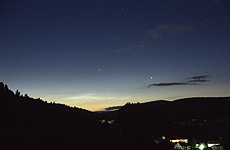 |
Am
Abend des 19. Juni 2005 war in Österreich die erste NLC des Jahres zu
beobachten. Weitere Sichtungen wurden aus Nord-, Mittel- und
Süddeutschland,
aus den Niederlanden und aus Großbritannien gemeldet.
In Austria the first NLC of the year 2005 was observed during the evening hours of June 19th. On this evening other observations were made in all parts of Germany, the Netherlands and Greatbritain. |
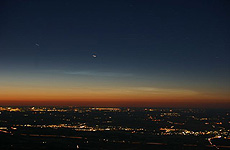 |
Wie
nicht anders zu erwarten, werden NLC´s bei aufmerksamer Beobachtung
auch aus südlichen mitteleuropäischen Breiten entdeckt: Um 23:09 MESZ konnte die
Leuchtende Nachtwolke vom Wendelstein
in Südbayern aus (47° 42' 15'' N; 12° 00' 46'' E) fotografiert werden!
Die Aufnahme wurde mir dankenswerterweise von Frau
Carolin Baumann zur Verfügung gestellt (http://steinderl.de).
As expected NLC´s are seen from low latitudes as well in Central Europe. At 21:09 UT Carolin Baumann took a picture of the Noctilucent Cloud from the top of the Wendelstein in southern Bavaria (47° 42' 15'' N; 12° 00' 46'' E)! Thanks to Carolin Baumann for using her image (http://steinderl.de). |
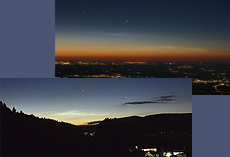 |
Interessant ist der unmittelbare
Vergleich der Aufnahmen aus Schlägl und vom
Wendelstein: Deutlich zeigt sich die Verschiebung der Wolke vorm Hintergrund der
Sterne.
It is intersting to compare the images taken in Schlägl and at the Wendelstein: Clearly you can see the shifting of the cloud infront of the stars. |
![]() 19. Juni
-
23. Juni
-
18. Juli
-
20.
Juli
19. Juni
-
23. Juni
-
18. Juli
-
20.
Juli
23. Juni 2005
 |
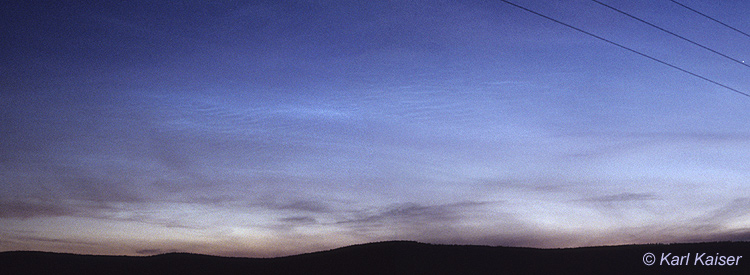 |
Schlägl, 23. Juni 2005, 03:45 (oben) und 03:53 (unten) MESZ: Die Leuchtende Nachtwolke änderte während der Beobachtung nur wenig ihre Lage und Form. Im Abstand der beiden Aufnahmen bewegte sie sich langsam nach links (deutlich an ihrem hellen unstrukturierten Bereich etwa in Bildmitte zu erkennen). Die dunklen Cirren zogen schneller nach Osten ab. Um 04:05 MESZ verblassten die Strukturen der NLC in der hellen Morgendämmerung.
The position and the shape of the NLC did not change conspicuously during the observation. Within 8 minutes (01:45 to 01:53 UT) the cloud moved to the left hand side slowly (take a look at the bright not structured area in the centre of the image). The dark cirrus clouds moved faster in an easterly direction. At 02:05 UT the NLC vanished in the brightening dawn.
Fotos: © Karl Kaiser; f = 58 mm; 1:2,8; 2 s (oben - upper image) und 1 s (unten); Kodak Elite 400. Jedes Bild ist ein Komposit aus 2 Aufnahmen (each picture is a composite of 2 images).
![]() 19. Juni
-
23. Juni
-
18. Juli
-
20.
Juli
19. Juni
-
23. Juni
-
18. Juli
-
20.
Juli
18. Juli 2005
Ab 15. Juli wurde der Dämmerungshimmel nur mehr sporadisch nach Leuchtenden Nachtwolken abgesucht, denn später als 11. Juli konnten während der vergangenen 11 Jahre keine NLC´s mehr von Österreich aus gesehen werden. Dies sollte sich allerdings im Jahr 2005 ändern:
Um 03:30 MESZ zeigte sich knapp überm NE-Horizont ein schwacher Wolkenstreifen. Selbst im Feldstecher, ein in niedrigen Breiten für die Erkennung schwacher NLC´s unbedingt notwendiger Begleiter der nächtlich Beobachtungen, waren die Strukturen zu wenig aussagekräftig. Knapp später erschienen im NNE überm Böhmerwald deutliche Bänder und Wellen ...
From July 15th on I watched the morning and evening sky sporadically only because it was never possible to observe NLC´s during the last 11 years in Austria later than 11th of July. But this should change during the period of 2005:
At 01:30 UT a weak cloud was seen above the northeast horizon. Even looking through the field-glass it was not possible to confirm the cloud as a NLC. Barely some minutes later another part of the cloud appeared over the Bohemian Forest showing bands and waves ...
... und schließlich sollte es eine der beeindruckendsten "österreichischen" Leuchtenden Nachtwolken werden:
... and finally this cloud was one of the most impressive Noctilucent Clouds ever watched in Austria:
Schlägl, 18. Juli 2005: Mit fortschreitender Dämmerung wurden immer mehr Details der Wolke sichtbar. Das Panoramabild, bestehend aus 3 zu einem Komposit zusammengefügten Bildern, wurde um 03:45 MESZ aufgenommen.
At 01:45 UT the NLC showed many details. The panorama is a composite of 3 images taken at 01:45 UT.
Foto: © Karl Kaiser; f = 58 mm; 1:2,8; 15 s; Kodak Elite 400. Komposit aus 3 Aufnahmen (composite of 3 images).
Schlägl, 18. Juli 2005: Das Kompositbild aus 4 Aufnahmen gibt einen Überblick über den gesamten Nordhorizont. Um 03:57 MESZ sind die NLC-Strukturen am deutlichsten ausgeprägt. Beachte auch den Wolkenteil knapp überm Horizont im Bild links! Ein großer Teil dieser außergewöhnlichen NLC blieb leider unterm Böhmerwaldkamm verborgen: ihre Höhe reichte bis 8°, ihre azimutale Ausdehnung umfasste ca. 90°! Die Strukturen der NLC schienen perspektivisch auseinander zulaufen, was auch für den westlichsten Teil der Wolke zutraf!
This image shows a survey of the complete northern horizon, 4 pictures are put together. At 01:57 UT the structures of the NLC are most clear. Look at the part of the cloud on the left side of the image! A large part of the extraordinary cloud hid behind the ridge of the mountains: the height of the upper edge reached 8°, the azimuthal extension was about 90°! As it seems the structures of the cloud converge perspectively!
Foto: © Karl Kaiser; f = 58 mm; 1:2,8; 8 s; Kodak Elite 400. Komposit aus 4 Aufnahmen (composite of 4 images).
|
|
Schlägl, 18. Juli 2005, 03:45 (oben) und 03:57 MESZ (unten): Der direkte Vergleich beider Panoramen führt uns die Veränderung der Wolke innerhalb von 12 Minuten vor Augen. Charakteristisch für diese NLC sind die vertikal bis schräg verlaufenden dichteren Abschnitte aus zahlreichen Wellen und Bändern! Klicken Sie links, in die Mitte oder rechts in das Bild, um vergrößerte Ausschnitte der Wolkenstrukturen zu sehen.
The comparison of both panoramas shows the changing of the cloud within 12 minutes (01:45 and 01:57 UT). The vertical and oblique parts consist of many waves and bands. Click on the left, middle and right part of the image to get enlarged views.
Foto: © Karl Kaiser; f = 58 mm; 1:2,8; 15 s (oben - upper image) und 8 s (unten); Kodak Elite 400.
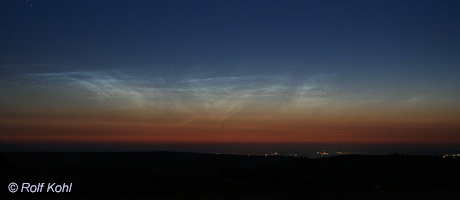 |
Am 18. Juli 2005 fotografierte Rolf Kohl (http://www.rjkole.de) vom Taunus aus Abschnitte des Wolkenkomplexes (Mitteldeutschland: 50° 26' 47" N; 8° 33' 47" E). Eindeutig lassen sich die selben Strukturen finden: zahlreiche Wellen, Bänder und die typisch vertikal angeordneten Bereiche! Öffnen Sie die Seite mit der direkten Gegenüberstellung beider Sichtungen! Dank an Rolf Kohl für die Bereitstellung des Bildes! |
| On the same day Rolf Kohl (http://www.rjkole.de) took images of the cloud at the Taunus (mountains in Germany, 50° 26' 47" N; 8° 33' 47" E). Clearly the same structures are seen: a lot of waves, bands and the vertically oriented parts! Take a look at the site comparing both sightings! Thanks to Rolf Kohl for using his image! | |
![]() 19. Juni
-
23. Juni
-
18. Juli
-
20.
Juli
19. Juni
-
23. Juni
-
18. Juli
-
20.
Juli
20. Juli 2005
Zum Abschluss der sehr erfolgreichen NLC-Saison 2005 zeigte sich am 20. Juli erst ab 03:50 MESZ eine schwach leuchtende, aus Bändern und Wellen bestehende NLC. Die Horizontsicht war durch Wolken stärker beeinträchtigt; so konnte die Wolke nur abschnittsweise erkannt werden. Ihre vertikale Ausdehnung lag bei maximal 8°. Die folgenden Bilder zeigen, dass durch schnell ziehende Wolken der Troposphäre Teile der NLC immer wieder verdeckt worden sind und neue aber zum Vorschein gekommen sind. Bemerkenswert ist, dass an diesem Morgen aus Mitteleuropa nur 1 weitere Sichtung gemeldet wurde: aus Rostock an der Ostsee.
The very successful NLC-season of the year 2005 was completed by a weak Noctilucent Cloud with bands and waves on July 20th. It appeared at 01:50 UT. The atmospherical conditions were not good because of low clouds at the horizon. Therefore, it was only possible to watch small parts of the NLC. The vertical extension was 8°. There was only one other observation in Central Europe this morning : Rostock at the Baltic Sea.
![]() 19. Juni
-
23. Juni
-
18. Juli
-
20.
Juli
19. Juni
-
23. Juni
-
18. Juli
-
20.
Juli
![]() Beobachtungsintervalle/times of
observations
Beobachtungsintervalle/times of
observations
Bilder/images: 1995, 1997, 1998, 1999, 2001, 2002, 2003, 2004, 2005, 2006, 2007, 2008, 2009
© 2008 - 2022 Karl Kaiser